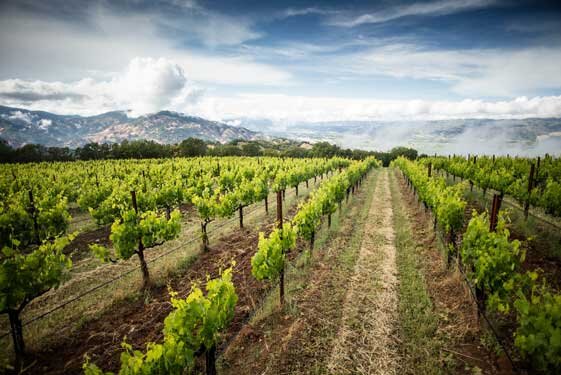Bonterra

An Example for the World Rooted in Mendocino Traditions
by Elizabeth Archer
Mendocino County is geographically enormous, but its agriculture businesses tend to be on the small side—diverse vegetable farms of an acre or less, estate wineries, and now boutique cannabis growers—whose distribution is limited to locals and lucky outsiders.
Bonterra Organic Vineyards is one of the exceptions, with widespread name recognition and distribution of half a million cases via major retailers in all 50 states and 20 countries. This size and scale provide the strength to commit to something that is already familiar in Mendocino but relatively new in the winemaking world: biodynamic certification.
Founded by the Fetzer family, Bonterra has been committed to sustainability for decades. Its first certified organic wines debuted in 1993. The Fetzer family are well known as local pioneers in organic and biodynamic farming, alongside other notable families like the Freys. Stewarded today by Chile’s Viña Concha y Toro, a global leader in winegrowing sustainability, Bonterra continues its commitment to sustainability as part of the Fetzer Vineyards portfolio.
“Sustainability is embedded in Mendocino grape growing, more so than any other California county that I know,” says Sebastian Donoso, a member of Bonterra’s winemaking team. “Sustainable practices are part of what make Mendocino County wines so exceptional.” Donoso was born in Santiago, Chile, and moved to the US at the age of 14. He graduated from Fresno State’s enology program in 2007. He started his career at Saracina in 2008, where he was introduced to organic farming, and continued his career at Campovida, where he started their winemaking program, before moving to Bonterra in 2017.
All of Bonterra’s 930 acres are certified organic, and 419 of those are also certified Biodynamic by Demeter USA. To officially convert land from organic to biodynamic takes about a year, depending on how quickly livestock can be incorporated and 10% of the land set aside for riparian areas. Otherwise, organic certification must be earned first, which takes about three years. Donoso and Director of Winemaking for Bonterra, Jeff Cichocki, work together with Director of Vineyard Operations, Joseph Brinkley, to determine which vineyard blocks to convert to biodynamic.
Biodynamic practices go above and beyond organic requirements, prioritizing not only healthy crops but also a healthy ecosystem. At Bonterra this includes the use of cover crops, animal grazing, integrated pest management, and wildlife inclusion. Almost half of Bonterra’s acreage is conserved in its natural state, including more than 50 acres of riparian habitat along the Russian River.
There are two classes of Biodynamic certification for wineries. The first prohibits the addition of anything except sulfur and allows winemakers to label their bottles as “Biodynamic Wine.” The second—which is how Bonterra and the vast majority of all Biodynamic winemakers operate—gives winemakers more flexibility, allowing organic additives such as yeast and tartaric acid, and carries a “made with Biodynamic grapes” label.
Biodynamic certification is still quite rare. There are fewer than 1,000 such wineries in the world. But according to Donoso, “There is a growing market for these special wines, as consumers learn more about the beneficial practices used on the farm and in the winery. Our aim is to share these wines with those eager to explore and learn more.”
There’s a reason that Biodynamic wine can cost more than conventional wine: in addition to being rare, Biodynamic wines take time to make. At Bonterra, each vineyard block is fermented and aged separately, and then Cichocki and Donoso work barrel to barrel to assemble the blend that best expresses the vineyard site as a whole. Says Donoso, “If we have to skip a year for our single-vineyard wines from Biodynamic grapes because we don’t feel the result would be a pure expression of the ranch, we skip it. We could make thousands of cases of Biodynamic wine, but we choose to produce fewer single-vineyard expressions to maintain their unique sense of place.” Any remaining wine appears in Bonterra’s organic lineup, which means that the average bottle at Trader Joe’s or Costco may contain at least a portion of Biodynamic grapes, at an accessible price.
Bonterra’s line of wines made with Biodynamic grapes comprises three blends made on three ranches. The Butler and McNab ranches produce 250 cases each of red blends called, appropriately, The McNab and The Butler. The Blue Heron Ranch produces 500 cases of chardonnay called The Roost, named after the blue herons who nest in the protected oak grove. These cases are mostly sold online to consumers in the U.S., and to restaurants and high-end wine shops.
“We don’t have to convince anybody in Mendocino of the merits of what we’re doing,” says Donoso. “It’s a lifestyle for a lot of people here.” But thanks to its size and reach, Bonterra is setting an example for how to make great wines while also stewarding the land, which other wineries around the state and globe can follow.
Bonterra is not open to the public and does not operate tasting rooms. Its biodynamic wines can be purchased online at bonterra.com.
Elizabeth Archer is a local food and farm enthusiast. She and her husband own and operate Carson and Bees, an inland-Mendocino-based beekeeping business, and she volunteers with the Good Farm Fund.



